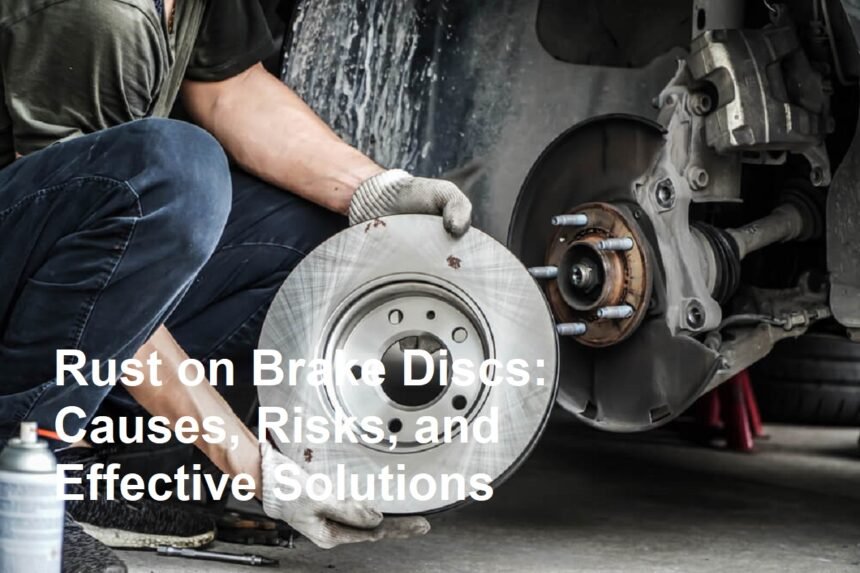Introduction
Car brake discs, also known as rotors, are essential components of a vehicle’s braking system. They ensure the vehicle slows down or stops effectively by providing a surface for the brake pads to press against. However, it’s common to notice rust forming on brake discs, especially if a vehicle is parked for an extended period or in humid environments. While some rust formation is normal, it can lead to various issues if not addressed properly. This article explores the causes of rust on brake discs, the disadvantages it causes, and effective solutions to prevent or eliminate it.
Causes of Rust on Car Brake Discs
- Exposure to Moisture:
The primary cause of rust on brake discs is exposure to water or humidity. When a vehicle is parked outside or in moist environments, water can settle on the surface of the brake rotors. Over time, this moisture reacts with the metal, forming rust. - Infrequent Use:
Vehicles that are used sporadically or are parked for long periods tend to develop rust on their brake discs. During regular driving, the brake pads scrape off the rust as they contact the disc, but if the car remains unused for weeks or months, rust can accumulate. - Lack of Protective Coating:
Some brake discs come with protective coatings to prevent rusting. If these coatings wear off or are not present, the metal exposed to the elements becomes vulnerable to rust. - Environmental Factors:
Areas with high humidity, frequent rain, or proximity to saltwater—such as coastal regions—accelerate rust formation because the salt and moisture increase corrosion rates. - Salt and Road Chemicals:
In winter, salt and other chemicals are often used on roads to melt snow and ice. These substances can settle on brake discs and accelerate rusting.
Disadvantages of Rusted Brake Discs
While surface rust on brake discs that forms after short-term parking is typically harmless and is usually cleaned off after a few brake applications, persistent or severe rusting can cause several issues:
- Reduced Braking Efficiency: Rust can create an uneven surface on the rotor, leading to decreased contact with the brake pads. This results in longer stopping distances and reduced braking performance.
- Vibrations and Noise: Rust buildup can cause vibrations or pulsations when braking, often felt through the brake pedal. These vibrations are not only uncomfortable but also indicative of uneven wear.
- Increased Wear and Damage: Rust can cause the brake pads to wear unevenly and accelerate the deterioration of the rotor surface. Over time, this can lead to the need for costly repairs or replacements.
- Corrosion and Structural Damage: In severe cases, rust can penetrate deep into the metal, causing structural weakening of the rotors, which can ultimately compromise safety.
Solutions to Prevent and Remove Rust on Brake Discs
The good news is that rust on brake discs is manageable and often preventable with proper care and maintenance. Here are some effective solutions:
- Regular Usage:
One of the easiest ways to prevent rust is to drive your vehicle regularly. Short trips may not generate enough heat to clean off surface rust, but consistent driving helps the brake pads scrape away rust buildup naturally. - Park in Dry, Covered Areas:
Whenever possible, park your vehicle in a garage or sheltered space to minimize exposure to moisture and humidity. - Apply Rust-Resistant Coatings:
Some brake discs come with protective coatings or rust inhibitors. If your vehicle does not have these, consider applying a rust-resistant coating specifically designed for automotive parts. - Use Disc Cleaners and Rust Removers:
If rust has already formed, brake disc cleaner sprays or rust removers can effectively dissolve rust. Use these products and then perform gentle braking to wipe off debris. - Mechanical Cleaning:
In cases of severe rust, mechanical removal using a wire brush or sanding can restore the surface of the rotor. This should be done carefully to avoid damaging the disc. - Professional Inspection and Maintenance:
Regular brake inspections by qualified mechanics can identify rust early. If rusting is extensive or causes vibration, replacing the rotors may be necessary.
Conclusion
Rust formation on car brake discs is a common issue mainly caused by exposure to moisture, infrequent use, and environmental factors. While surface rust that forms during short-term parking is usually harmless and cleans off through normal braking, persistent rust can impair braking performance and cause long-term damage. Regular driving, parking in dry environments, applying protective coatings, and routine maintenance are effective strategies to prevent and address rust on brake discs. Proper care not only extends the lifespan of brake components but also ensures safety and optimal vehicle performance.












